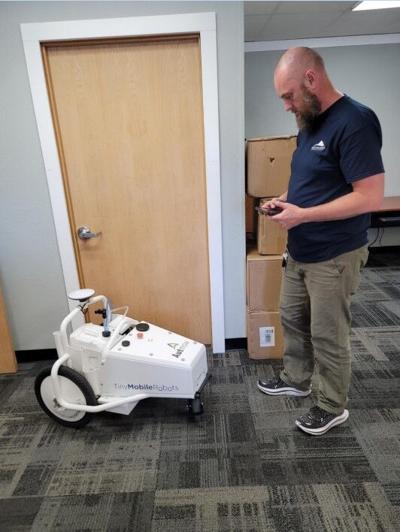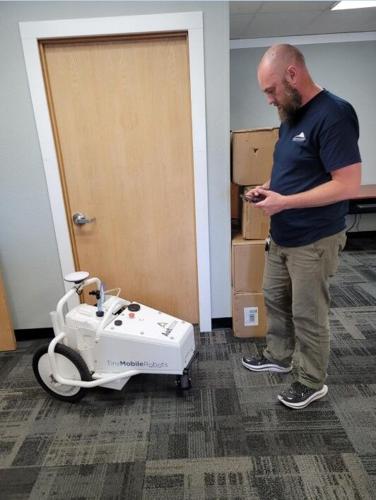“I think it’s just a reminder, too, that when schools have historically been designed, they’re hubs of community — it doesn’t always equate to maybe what we envision as the most secure facility.”
Kyle Rosselle
Director of safety and security
HOOD RIVER — Operations and safety brought Hood River County School District administration and the new school resource deputy together to update board members and the community during the Sept. 28 meeting.
Chief Financial Officer Doug Holmes, Director of Safety and Security Kyle Rosselle, Director of Operations Todd Rainwater and Human Resources Director Catherine Dalbey — the district’s Safety Team — were joined by School Resource Deputy Pete Hughes to present an overview of the district’s progress towards achieving its strategic plan goal of “prioritize health and safety as a critical component of school success.”
The presentation covered a lot of ground, including keeping students and staff cool during heat events, bus routes and safety, maintenance and facility care, and the never-ending work around school security.
“This summer was hot,” Rosselle began, “and we have been working hard as a district to identify and develop strategies around how to deal with the heat. It’s not going away; it’s getting more intense, it’s lasting longer and it’s coming on earlier and staying later, so we need to become more prepared for that … Some of the temperatures in our buses, for example, were extreme — windows were over 130 degrees, according to temperature guns,” he said.
The district is working to implement air conditioning, with a goal of three buses equipped with full-length AC by the start of next year’s summer school program. They’re utilizing similar strategies around wildfire smoke.
Rosselle additionally reported the district is looking to hire seven additional bus drivers; currently, 21 drivers (two of whom are the district’s mechanics) cover 439,646 miles each day and 1,761 students are transported on a bus fleet that is, on average, 12 years old.
“You may see our sports teams on Mid-Columbia or North Wasco or Corbett school buses and that’s how we’re helping to make ends meet with trip requests and activity requests,” Rosselle said.
Rainwater walked board members through current maintenance and operations staffing; there are a total of 126.76 acres (5,521,665.5 square feet) of grounds and 1,544,678 square feet of facilities space between all the sites, with work being done by a limited staff — though he believes five open positions will soon be filled.
“The challenge that we’ve had going through COVID and post-COVID, I’ve had weeks where I’ve had three maintenance people for weeks on end, whether people were out sick, they were on personal leave, (or) any number of reasons and we just have to run and operate and prioritize as best we can and get everything done,” he said.
He’s been utilizing contractors for grounds maintenance and sees that as a potential solution on the custodial side as well. Another “out of the box” solution: Working with new technologies. He recently purchased an automated field striper, which can stripe a field from scratch in 25 minutes; it generally takes two crew members four or five hours each to stripe a lacrosse field, for example.
“With this kind of machine, my grounds team can go out, set this machine to stripe and while that’s striping, they can be moving onto fields, trimming spraying whatever needs to be done,” he said.
Hughes gave an overview of the School Resource Deputy program, stemming from work that was begun in 2008 by a small group of people getting together regularly to talk about school safety. In time, the group expanded to include partnerships with multiple agencies. Now, the district’s school safety model has been borrowed by other districts, including North Wasco.
“We’re really proud of the work that we’ve done,” Hughes said. “We’ve had a meeting almost once a month for 14 years now working on this subject matter.”
He called school security a continual process, saying lessons learned from events happening nationwide show them what could make the district’s plan better.
“And that’s never going to go away. If we stop doing that we’ll be behind the curve really, really fast,” he said. “We’ll never stop working on this because once you finish one project, you’ll have something else that will have dilapidated to some degree or some technology that will help moving forward.”
Rosselle recently spearheaded a safety audit of interior and exterior spaces around the district by Columbia Gorge ESD (Education Service District) and Clackamas ESD, with recommendations coming soon. “We’re also talking about policies and practices and drill schedules and the relationships with our agencies,” he said. “I think it’s just a reminder, too, that when schools have historically been designed, they’re hubs of community — it doesn’t always equate to maybe what we envision as the most secure facility.”
Holmes said that grant funding has been utilized to focus on facility assessments ($20,000, to be completed by December) and that long-range facilities assessments and seismic assessments are also slated, with a completion date of December 2023 (each $25,000). A new Defensible Spaces Grant ($5,000) for fire prevention has also been received.
The next board meeting will be held Oct. 26 at Parkdale Elementary.













Commented
Sorry, there are no recent results for popular commented articles.